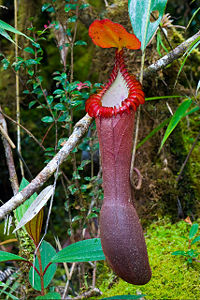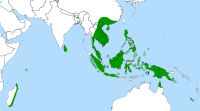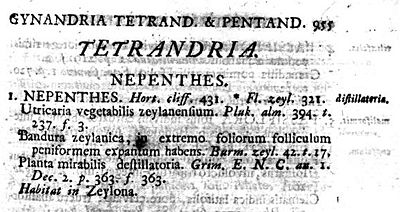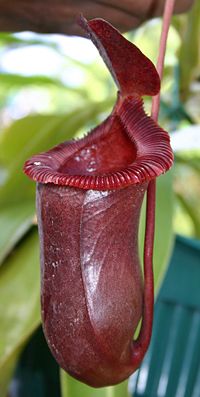Nepenthes
| Nepenthes | ||||||||||||
|---|---|---|---|---|---|---|---|---|---|---|---|---|
 Upper pitcher of Nepenthes edwardsiana
|
||||||||||||
| Scientific classification | ||||||||||||
|
||||||||||||
| Diversity | ||||||||||||
| ~120 species | ||||||||||||
 Global distribution of Nepenthes.
|
||||||||||||
| Species | ||||||||||||
|
See below or separate list. |
||||||||||||
| Synonyms | ||||||||||||
|
The Nepenthes (pronounced /nəˈpɛnθiːz/, from Greek: ne = not, penthos = grief, sorrow; named after the ancient drug Nepenthe), popularly known as Tropical Pitcher Plants or Monkey Cups, are a genus of carnivorous plants in the monotypic family Nepenthaceae that comprises roughly 120 species, numerous natural and many cultivated hybrids. They are vine-forming plants of the Old World tropics, ranging from South China, Indonesia, Malaysia and the Philippines; westward to Madagascar (2 species) and the Seychelles (1); southward to Australia (3) and New Caledonia (1); and northward to India (1) and Sri Lanka (1). The greatest diversity occurs on Borneo and Sumatra with many endemic species. Many are plants of hot humid lowland areas, but the majority are tropical montane plants, receiving warm days but cool to cold humid nights year round. A few are considered tropical alpine with cool days and nights near freezing. The name 'Monkey Cups' refers to the fact that monkeys have been observed drinking rainwater from these plants.
Contents |
Etymology
The name Nepenthes was first published in 1737 in Carolus Linnaeus's Hortus Cliffortianus.[1] It references a passage in Homer's Odyssey, in which the potion "Nepenthes pharmakon" is given to Helen by an Egyptian queen. "Nepenthe" literally means "without grief" (ne = not, penthos = grief) and, in Greek mythology, is a drug that quells all sorrows with forgetfulness. Linnaeus explained:
If this is not Helen's Nepenthes, it certainly will be for all botanists. What botanist would not be filled with admiration if, after a long journey, he should find this wonderful plant. In his astonishment past ills would be forgotten when beholding this admirable work of the Creator! (translated from Latin by Harry Veitch)[2]
The plant Linnaeus described was Nepenthes distillatoria, a species from Sri Lanka.[3]
Nepenthes was formally published as a generic name in 1753 in Linnaeus's famous Species Plantarum, which established botanical nomenclature as it exists today. N. distillatoria is the type species of the genus.[4]

Botanical history

Almagestum Botanicum of 1696.
The earliest known record of Nepenthes dates back to the 17th century. In 1658, French colonial governor Etienne de Flacourt published a description of a pitcher plant in his seminal work Histoire de la Grande Isle de Madagascar. It reads:[5]
It is a plant growing about 3 feet high which carries at the end of its leaves, which are 7 inches long, a hollow flower or fruit resembling a small vase, with its own lid, a wonderful sight. There are red ones and yellow ones, the yellow being the biggest. The inhabitants of this country are reluctant to pick the flowers, saying that if somebody does pick them in passing, it will not fail to rain that day. As to that, I and all the other Frenchmen did pick them, but it did not rain. After rain these flowers are full of water, each one containing a good half-glass. [translated from French in Pitcher-Plants of Borneo][3]
Flacourt called the plant Anramitaco, presumably after a local name. More than a century later, this species was formally described as N. madagascariensis.[6]
The second species to be described was N. distillatoria, the Sri Lankan endemic. In 1677, Bartholinus made brief mention of it under the name Miranda herba, Latin for "marvellous herb".[7] Three years later, Dutch merchant Jacob Breyne referred to this species as Bandura zingalensium, after a local name for the plant.[8] Bandura subsequently became the most commonly used name for the tropical pitcher plants, until Linnaeus coined Nepenthes in 1737.[3]
N. distillatoria was again described in 1683, this time by Swedish physician H. N. Grimm.[9] Grimm called it Planta mirabilis distillatoria or the "miraculous distilling plant", and was the first to clearly illustrate a tropical pitcher plant.[3] Three years later, in 1686, English naturalist John Ray quoted Grimm as saying:[10]
The root draws up moisture from the earth which with the help of the sun's rays rises up into the plant itself and then flows down through the stems and nerves of the leaves into the natural utensil to be stored there until used for human needs. [translated from Latin in Pitcher-Plants of Borneo][3]
One of the earliest illustrations of Nepenthes appears in Leonard Plukenet's Almagestum Botanicum of 1696.[11] The plant, called Utricaria vegetabilis zeylanensium, is undoubtedly N. distillatoria.[3]

It was around the same time that German botanist Georg Eberhard Rumphius discovered two new Nepenthes species in the Malay Archipelago. Rumphius illustrated the first one, now considered synonymous with N. mirabilis, and gave it the name Cantharifera, meaning "tankard-bearer". The second, referred to as Cantharifera alba, is thought to have been N. maxima. Rumphius described the plants in his most famous work, the six-volume Herbarium Amboinense, a catalogue of the flora of Ambon Island. However, it would not be published until many years after his death.[12]
After going blind in 1670, when the manuscript was only partially complete, Rumphius continued work on Herbarium Amboinensis with the help of clerks and artists. In 1687, with the project nearing completion, at least half of the illustrations were lost in a fire. Persevering, Rumphius and his helpers first completed the book in 1690. However, two years later, the ship carrying the manuscript to the Netherlands was attacked and sunk by the French, forcing them to start over from a copy that had fortunately been retained by Governor-General Johannes Camphuijs. The Herbarium Amboinensis finally arrived in the Netherlands in 1696. Even then, the first volume did not appear until 1741, thirty-nine years after Rumphius's death. By this time, Linnaeus's name Nepenthes had become established.[3]

N. distillatoria was again illustrated in Johannes Burmann's Thesaurus Zeylanicus of 1737. The drawing depicts the end of a flowering stem with pitchers. Burmann refers to the plant as Bandura zeylanica.[13]
The next mention of tropical pitcher plants was made in 1790, when Portuguese priest João de Loureiro described Phyllamphora mirabilis, or the "marvellous urn-shaped leaf", from Vietnam. Despite living in the country for around 35 years, it seems unlikely that Loureiro observed living plants of this species, as he states that the lid is a moving part, actively opening and closing. In his most celebrated work, Flora Cochinchinensis, he writes:[14]
[...] (the) leaf-tip ends in a long hanging tendril, twisted spirally in the middle, from which hangs a sort of vase, oblong, pot-bellied, with a smooth lip with a projecting margin and a lid affixed to one side, which of its own nature freely opens and closes in order to receive the dew and store it. A marvellous work of the Lord! [translated from French in Pitcher-Plants of Borneo][3]
Phyllamphora mirabilis was eventually transferred to the genus Nepenthes by George Claridge Druce in 1916.[15] As such, P. mirabilis is the basionym of this most cosmopolitan of tropical pitcher plant species.[16]
Loureiro's description of a moving lid was repeated by Jean Louis Marie Poiret in 1797. Poiret described two of the four Nepenthes species known at the time: N. madagascariensis and N. distillatoria. He gave the former its current name and called the latter Nepente de l'Inde, or simply "Nepenthes of India", although this species is absent from the mainland. In Jean-Baptiste Lamarck's Encyclopédie Méthodique Botanique, he included the following account:[6]
This urn is hollow, as I have just said, usually full of soft, clear water, and then closed. It opens during the day and more than half the liquid disappears, but this loss is repaired during the night, and the next day the urn is full again and closed by its lid. This is its sustenance, and enough for more than one day because it is always about half-full at the approach of night. [translated from French in Pitcher-Plants of Borneo][3]

With the discovery of new species, interest in Nepenthes grew throughout the 19th century, culminating in what has been called the "Golden Age of Nepenthes" in the 1880s.[3] However, the popularity of the plants dwindled in the early 20th century, before all but disappearing by World War II. This is evidenced by the fact that no new species were described between 1940 and 1966. The revival of global interest in the cultivation and study of Nepenthes is credited to Japanese botanist Shigeo Kurata, whose work in the 1960s and 1970s did much to bring attention to these plants.[17]
Morphology and function
The plants usually consist of a shallow root system and a prostrate or climbing stem, often several metres long, and usually 1 cm or less in diameter, although this may be thicker in a few species (e.g. N. bicalcarata). From the stems arise leaf-like expanded petioles, similar to certain Citrus spp., ending in a tendril, which in some species aid in climbing, and at the end of which forms the pitcher, considered the true leaf. The pitcher starts as a small bud and gradually expands to form a globe- or tube-shaped trap.

The trap contains a fluid of the plant's own production, which may be watery or syrupy and is used to drown the prey. Research has shown that this fluid contains viscoelastic biopolymers that may be crucial to the retention of insects within the traps of many species. The trapping efficiency of this fluid remains high, even when significantly diluted by water, as inevitably happens in wet conditions.[18]
The lower part of the trap contains glands which absorb nutrients from captured prey. Along the upper inside part of the trap is a slick waxy coating which makes the escape of its prey nearly impossible. Surrounding the entrance to the trap is a structure called the peristome (the "lip") which is slippery and often quite colorful, attracting prey but offering an unsure footing. Above the peristome is a lid (the operculum): in many species this keeps rain from diluting the fluid within the pitcher, the underside of which may contain nectar glands which attract prey.
Nepenthes usually produce two types of pitchers. Appearing near the base of the plant are the large lower traps, which typically sit on the ground, while the upper pitchers may be smaller, colored differently, and have different features than the lower pitchers. These upper pitchers usually form as the plant reaches maturity and the plant grows taller. To keep the plant steady, the upper pitchers form a loop in the tendril, allowing it to wrap around nearby support. In some species (e.g. N. rafflesiana) different prey may be attracted by different types of pitchers.
Prey usually consists of insects, but the largest species (N. rajah, N. rafflesiana, etc.) may occasionally catch small vertebrates, such as rats and lizards.[19][20] Flowers occur in racemes or more rarely in panicles with male and female flowers on separate plants. Seed is produced in a four-sided capsule which may contain 10-60 or more seeds, consisting of a central ovary and two wings, one on either side. Seeds are wind distributed.
Cultivation

Nepenthes may be cultivated in greenhouses. Easier species include N. alata, N. ventricosa, N. khasiana, and N. sanguinea. These four species are highlanders (N. alata has both lowland and highland forms), some easy lowlander species are N. rafflesiana, N.bicalcarata, N.mirabilis, and N.hirsuta.
"Highlander" forms are those species that grow in habitats that are generally higher up in elevation, and thus exposed to cooler evening temperatures. "Lowlander" forms are those species that grow nearer to sealevel.
Both forms respond best to rainwater (but tap water works as long as you flush it out with rainwater every month or if you have soft water), bright light (not full sun), a well drained medium, good air circulation and a relatively high humidity, although easier species such as N. alata can adapt to lower humidity environments. Highland species must have night-time cooling to thrive in the long-term. Chemical fertilisers are best used at low strength. Occasional feeding with frozen (thawed before use) crickets may be beneficial. Terrarium culture of smaller plants like N. bellii, N. × trichocarpa and N. ampullaria is possible, but most plants will get too large over time.
Plants can be propagated by seed, cuttings, and tissue culture. Seeds may be sown on damp chopped Sphagnum moss, or on sterile plant tissue culture media once they have been properly disinfected. The seeds generally become inviable soon after harvesting, so seed are not usually the preferred method of propagation. A 50:50 mixture of orchid medium with moss or perlite is suitable for germination and culture. Seed may take two months to germinate, and two years or more to yield mature plants. Cuttings may be rooted in damp Sphagnum moss in a plastic bag or tank with high humidity and moderate light. They can begin to root in 1-2 months and start to form pitchers in about six months. Tissue culture is now used commercially and helps reduce collection of wild plants, as well as making many rare species available to hobbyists at reasonable prices. Nepenthes are considered threatened or endangered plants and are listed in CITES appendices 1 & 2.
Species
More than 100 species of Nepenthes are currently recognised as valid. This number is fast increasing, with one to two new species being described each year.[17]
Hybrids and cultivars
- See also: List of Nepenthes natural hybrids



There are many hybrid Nepenthes and numerous named cultivars. The following are named natural hybrids:
- N. × alisaputrana (N. burbidgeae × N. rajah)
- N. × bauensis (N. gracilis × N. northiana)
- N. × cantleyi (N. bicalcarata × N. gracilis)
- N. × cincta (N. albomarginata × N. northiana)
- N. × ferrugineomarginata (N. albomarginata × N. reinwardtiana)
- N. × ghazallyana (N. gracilis × N. mirabilis)
- N. × harryana (N. edwardsiana × N. villosa)
- N. × hookeriana (N. ampullaria × N. rafflesiana)
- N. × kinabaluensis (N. rajah × N. villosa)
- N. × kuchingensis (N. ampullaria × N. mirabilis)
- N. × merrilliata (N. alata × N. merrilliana)
- N. × mirabilata (N. alata × N. mirabilis)
- N. × pangulubauensis (N. mikei × N. pectinata)
- N. × pyriformis (N. inermis × N. talangensis)
- N. × sarawakiensis (N. muluensis × N. tentaculata)
- N. × trichocarpa (N. ampullaria × N. gracilis)
- N. × truncalata (N. alata × N. truncata)
- N. × trusmadiensis (N. lowii × N. macrophylla)
- N. × tsangoya ((N. alata × N. merrilliana) × N. mirabilis)
- N. × ventrata (N. alata × N. ventricosa)
Some of the more well known artificially produced hybrids include:
- N. 'Coccinea' ((N. rafflesiana × N. ampullaria) × N. mirabilis)
- N. 'Emmarene' (N. khasiana × N. ventricosa)
- N. 'Gentle' (N. fusca × N. maxima)
- N. 'Judith Finn' (N. veitchii × N. spathulata)
- N. 'Miranda' ((N. maxima × N. northiana) × N. maxima)
- N. 'Mixta' (N. northiana × N. maxima)
See also
- Nepenthes classification
- Nepenthes infauna
References
- ↑ Linnaeus, C. 1737. Nepenthes. Hortus Cliffortianus. Amsterdam.
- ↑ Veitch, H.J. 1897. Nepenthes. Journal of the Royal Horticultural Society 21(2): 226–262.
- ↑ 3.0 3.1 3.2 3.3 3.4 3.5 3.6 3.7 3.8 3.9 Phillipps, A. & A. Lamb 1996. Pitcher-Plants of Borneo. Natural History Publications (Borneo), Kota Kinabalu.
- ↑ Linnaeus, C. 1753. Nepenthes. Species Plantarum 2: 955.
- ↑ de Flacourt, E. 1658. Histoire de la Grande Isle de Madagascar.
- ↑ 6.0 6.1 Poiret, J.L.M. 1797. Népente. In: J.B. Lamarck Encyclopédie Méthodique Botanique Vol. 4.
- ↑ Bartholinus 1677. Miranda herba. Acta Medica et Philosophica Hafniensa 3: 38.
- ↑ Breyne, J. 1680. Bandura zingalensium etc. Prodromus Fasciculi Rariorum Plantarum 1: 18.
- ↑ Grimm, H.N. 1683. Planta mirabilis distillatoria. In: Miscellanea curiosa sive Ephemeridum. Med. Phys. Germ. Acad. Nat. Cur. Decuriae 2, ann. prim. p. 363, f. 27.
- ↑ Ray, J. 1686. Bandura cingalensium etc. Historia Plantarum 1: 721–722.
- ↑ Plukenet, L. 1696. Utricaria vegetabilis zeylanensium. In: Almagestum Botanicum.
- ↑ Rumphius, G.E. 1741–1750. Cantharifera. In: Herbarium Amboinense 5, lib. 7, cap. 61, p. 121, t. 59, t. 2.
- ↑ Burmann, J. 1737. Thesaurus Zeylanicus. Amsterdam.
- ↑ de Loureiro, J. 1790. Flora Cochinchinensis 2: 606–607.
- ↑ Druce, G. 1916. Nepenthes mirabilis. In: Botanical Exchange Club of the British Isles Report 4: 637.
- ↑ Clarke, C.M. 1997. Nepenthes of Borneo. Natural History Publications (Borneo), Kota Kinabalu.
- ↑ 17.0 17.1 Clarke, C.M. & C.C. Lee 2004. Pitcher Plants of Sarawak. Natural History Publications (Borneo), Kota Kinabalu.
- ↑ Gaume, L. & Y. Forterre 2007. A Viscoelastic Deadly Fluid in Carnivorous Pitcher Plants. PLoS ONE 2(11): e1185. doi:10.1371/journal.pone.0001185
- ↑ Phillipps, A. 1988. A Second Record of Rats as Prey in Nepenthes rajah. Carnivorous Plant Newsletter 17(2): 55.
- ↑ Moran, J.A. 1991. The role and mechanism of Nepenthes rafflesiana pitchers as insect traps in Brunei. Ph.D. thesis, University of Aberdeen, Aberdeen, Scotland.
- Danser's Monograph on Nepenthes (covers species from Malaysia, Indonesia and New Guinea, but not elsewhere)
- Nepenthaceae in: Watson, L., and M. J. Dallwitz (1992 onwards). The Families of Flowering Plants. Descriptions, Illustrations, Identification, Information Retrieval.
Further reading
- Amagase, S., S. Nakayama & A. Tsugita 1969. Acid protease in Nepenthes. II. Study on the specificity of nepenthesin. The Journal of Biochemistry 66(4): 431–439.
- Athauda, S.B.P., K. Matsumoto, S. Rajapakshe, M. Kuribayashi, M. Kojima, N. Kubomura-Yoshida, A. Iwamatsu, C. Shibata, H. Inoue & K. Takahashi 2004. Enzymatic and structural characterization of nepenthesin, a unique member of a novel subfamily of aspartic proteinases.PDF (1.32 MiB) (manuscript BJ20031575) Biochemical Journal 381(1): 295–306.
- Bauer, U., Bohn, H.F. & Federle, W. 2008. Harmless nectar source or deadly trap: Nepenthes pitchers are activated by rain, condensation and nectar.PDF Proceedings of the Royal Society B 275(1632): 259-265.
- Beaver, R.A. 1979. Biological studies of the fauna of pitcher plants Nepenthes in west Malaysia. Annales de la Société Entomologique de France 15: 3–17.
- Beaver, R.A. 1979. Fauna and foodwebs of pitcher plants in west Malaysia. Malayan Nature Journal 33: 1–10.
- Beaver, R.A. 1983. The communities living in Nepenthes pitcher plants: fauna and food webs. In: J.H. Frank & L.P. Lounibos (eds.) Phytotelmata: Plants as Hosts for Aquatic Insect Communities. Plexus Publishing, New Jersey. pp. 129–159.
- Beaver, R.A. 1985. Geographical variation in food web structure in Nepenthes pitcher plants. Ecological Entomology 10: 241–248.
- Beekman, E.M. 2004. A Note on the Priority of Rumphius' Observation of Decapod Crustacea Living In Nepenthes. Crustaceana 77(8): 1019–1021. doi:10.1163/1568540042781748
- Bohn, H.F. & W. Federle 2004. Insect aquaplaning: Nepenthes pitcher plants capture prey with the peristome, a fully wettable water-lubricated anisotropic surface.PDF Proceedings of the National Academy of Sciences 101(39): 14138–14143.
- Carlquist, S. 1981. Wood Anatomy of Nepenthaceae. Bulletin of the Torrey Botanical Club 108(3): 324–330. doi:10.2307/2484711
- Chia, T.F., H.H. Aung, A.N. Osipov, N.K. Goh & L.S. Chia 2004. Carnivorous pitcher plant uses free radicals in the digestion of prey. Redox Report 9(5): 255–261. doi:10.1179/135100004225006029
- Frazier, C.K. 2000. The Enduring Controversies Concerning the Process of Protein Digestion in Nepenthes. Carnivorous Plant Newsletter 29(2): 56–61.
- Meimberg, H., A. Wistuba, P. Dittrich & G. Heubl 2001. Molecular Phylogeny of Nepenthaceae Based on Cladistic Analysis of Plastid trnK Intron Sequence Data. Plant Biology (Stuttgart, Germany) 3: 164–175. doi:10.1055/s-2001-12897
- Mogi, M. & H.S. Yong 1992. Aquatic arthropod communities in Nepenthes pitchers: the role of niche differentiation, aggregation, predation and competition in community organization. Oecologia 90: 172–184.
- Mokkamul, P., A. Chaveerach, R. Sudmoon & T. Tanee 2007. Species Identification and Sex Determination of the Genus Nepenthes (Nepenthaceae).PDF (702 KiB) Pakistan Journal of Biological Sciences 10(4): 561–567.
- Moran, J.A., W.E. Booth & J.K. Charles 1999. Aspects of Pitcher Morphology and Spectral Characteristics of Six Bornean Nepenthes Pitcher Plant Species: Implications for Prey Capture.PDF Annals of Botany 83: 521–528.
- Osunkoya, O.O., S.D. Daud, B. Di-Giusto, F.L. Wimmer & T.M. Holige 2007. Construction Costs and Physico-chemical Properties of the Assimilatory Organs of Nepenthes Species in Northern Borneo. Annals of Botany 99(5): 895–906. doi:10.1093/aob/mcm023
- Pavlovič, A., E. Masarovičová & J. Hudák 2007. Carnivorous Syndrome in Asian Pitcher Plants of the Genus Nepenthes. Annals of Botany 100(3): 527–536. doi:10.1093/aob/mcm145
- Riedel, M., A. Eichner, H. Meimberg & R. Jetter 2007. Chemical composition of epicuticular wax crystals on the slippery zone in pitchers of five Nepenthes species and hybrids. Planta 225(6): 1517–1534. doi:10.1007/s00425-006-0437-3
- Schulze, W., W.B. Frommer & J.M. Ward 1999. Transporters for ammonium, amino acids and peptides are expressed in pitchers of the carnivorous plant Nepenthes.PDF The Plant Journal 17(6): 637–646.
- Vines, S.H. 1876. On the Digestive Ferment of Nepenthes. Journal of Anatomy and Physiology 11(1): 124–127.
External links
|
||||||||||||||